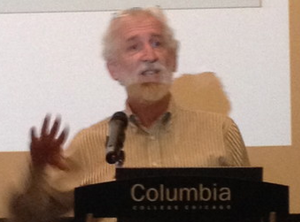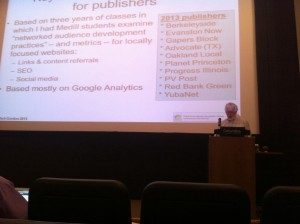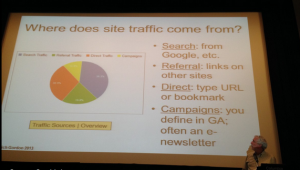
Ever wonder how you’re measuring up in digital success with Web and Social Analytics? Ever wonder what all those numbers mean in Google Analytics?
If so, Rich Gordon’s lecture on those topics during the LION Publishers Summit held Oct. 3-5 at Columbia College Chicago was a must hear. Gordon, a professor at Medill School of Journalism at Northwestern University and director of Digital Innovation at the school, provided some clarity on some of the skewed numbers being tossed about these days that determine a site’s overall success.
Gordon was quick to point out the biggest problems facing publishers today.
“The major problem for publishers today is that there is more data than we know what to do with…and deciding what we should keep track of,” Gordon said.
One of the fundamental roles of a publisher is to attract people to visit your site, said Gordon. But once a visitor enters a site, the true challenge is keeping him/her there for a longer duration.
But determining how many likes/visits have been made on your site and then improving upon those numbers can get a little tricky. Gordon said Google Analytics is a work in progress and the way visit duration is calculated is a “meaningless measure;” the simple reason being that Google Analytics doesn’t know when you’ve left the site.
Google Analytics only counts “clicks” on a site. So, whether someone visits a site for a second or a minute, the numbers can’t be tracked.
And those become increasingly misleading when dealing with search traffic. The challenge involved with search traffic comes when attempting to measure the people who typed in the name of your site intentionally, your URL, versus the people who just typed in a key word and happened to stumble upon your site.
More problems for publishers arise when someone types in your URL and then leaves very quickly, also known as the “bounce rate”, said Gordon. Gordon argued that by lowering the bounce rate on a site, naturally, it will contribute to more likes and visits. He says that when someone visits/stumbles upon a home page, is content with only that page and then leaves, is a major problem publishers should be focused on fixing.
“You should be thinking, are we doing everything we can to lure people into spending more time on our site,” Gordon said.
Gordon said he believes that there are three vital categories of metrics to take a close look at when trying to improve your site: raw volume, how often people come back and time spent on a site.
In addition, Gordon argued that some additional problems for publishers arise when dealing with metrics associated with Facebook, like social media. Since Facebook is constantly changing, there is no clear way to know just how many “likes” on a page are legitimate. Page views can also be easily manipulated.
“I’ve seen content on my Facebook feed that I’ve liked, but have not clicked “like” or commented on it, so there is no way Facebook can know that I liked it,” Gordon said.
So, if someone is looking to expand their digital success, Gordon will be teaching a course in January at Northwestern University that delves further into determining Web Analytics, and helps to get a site’s analytics moving in the right direction. For more information, tweet @Richgor.











Be First to Comment